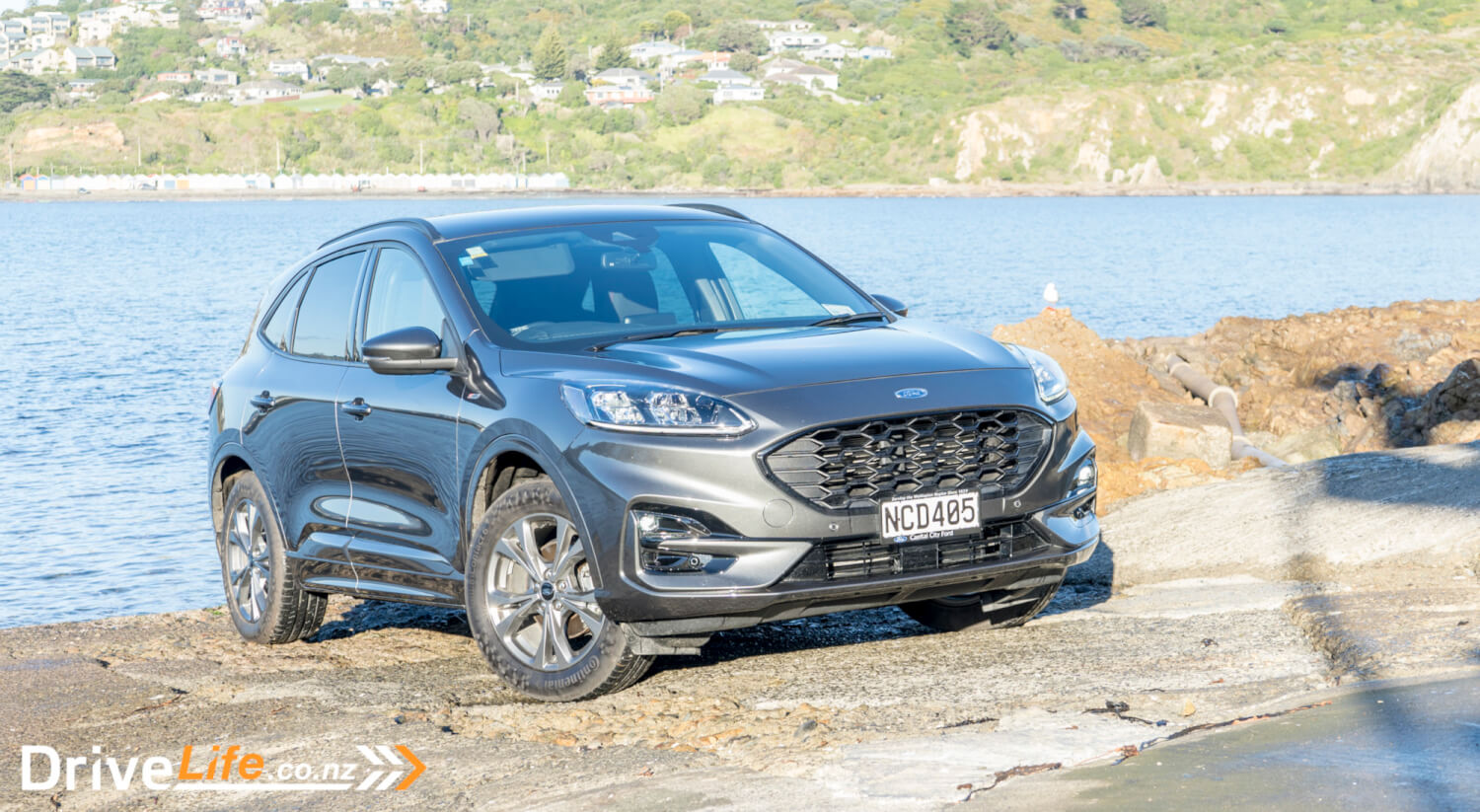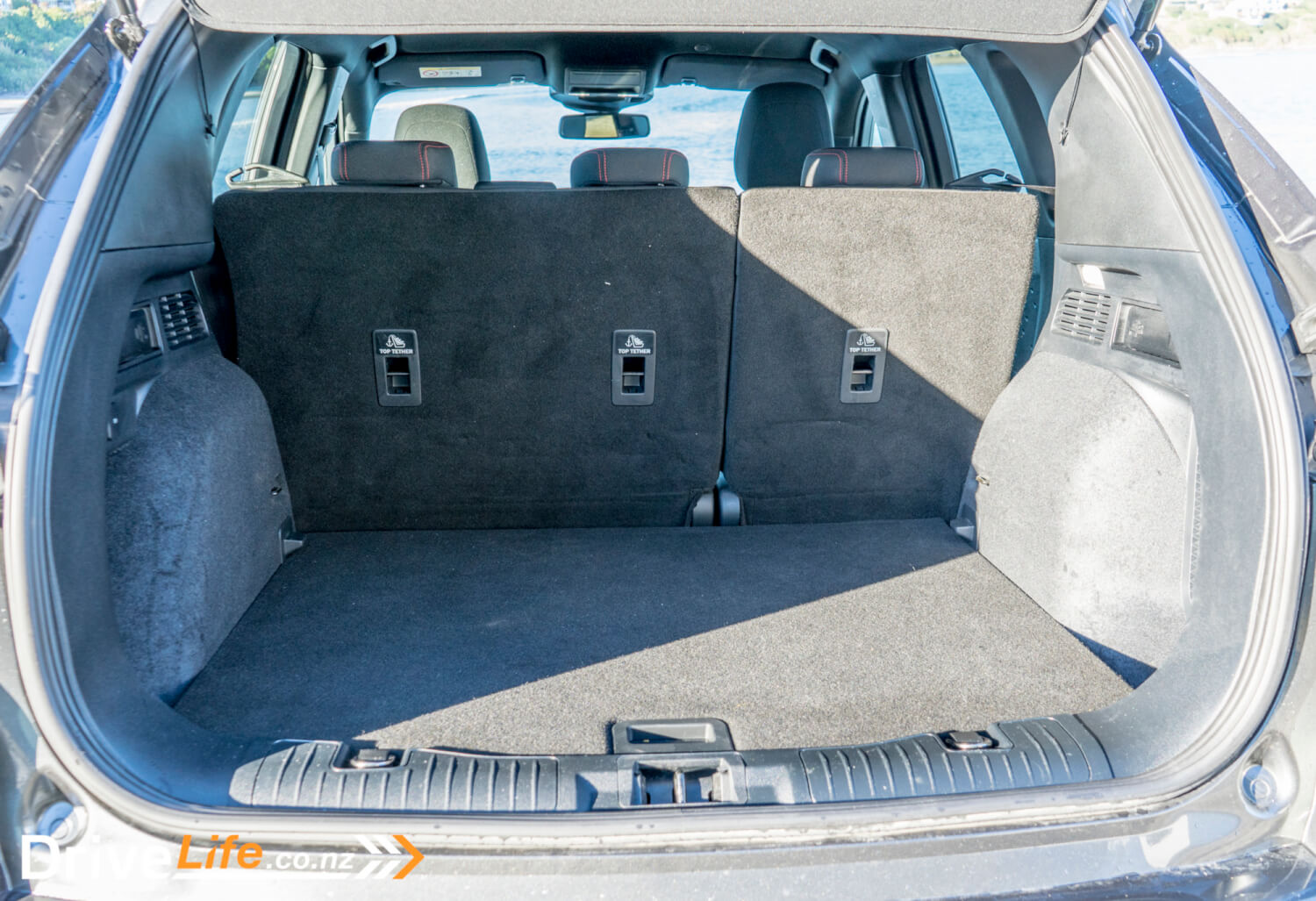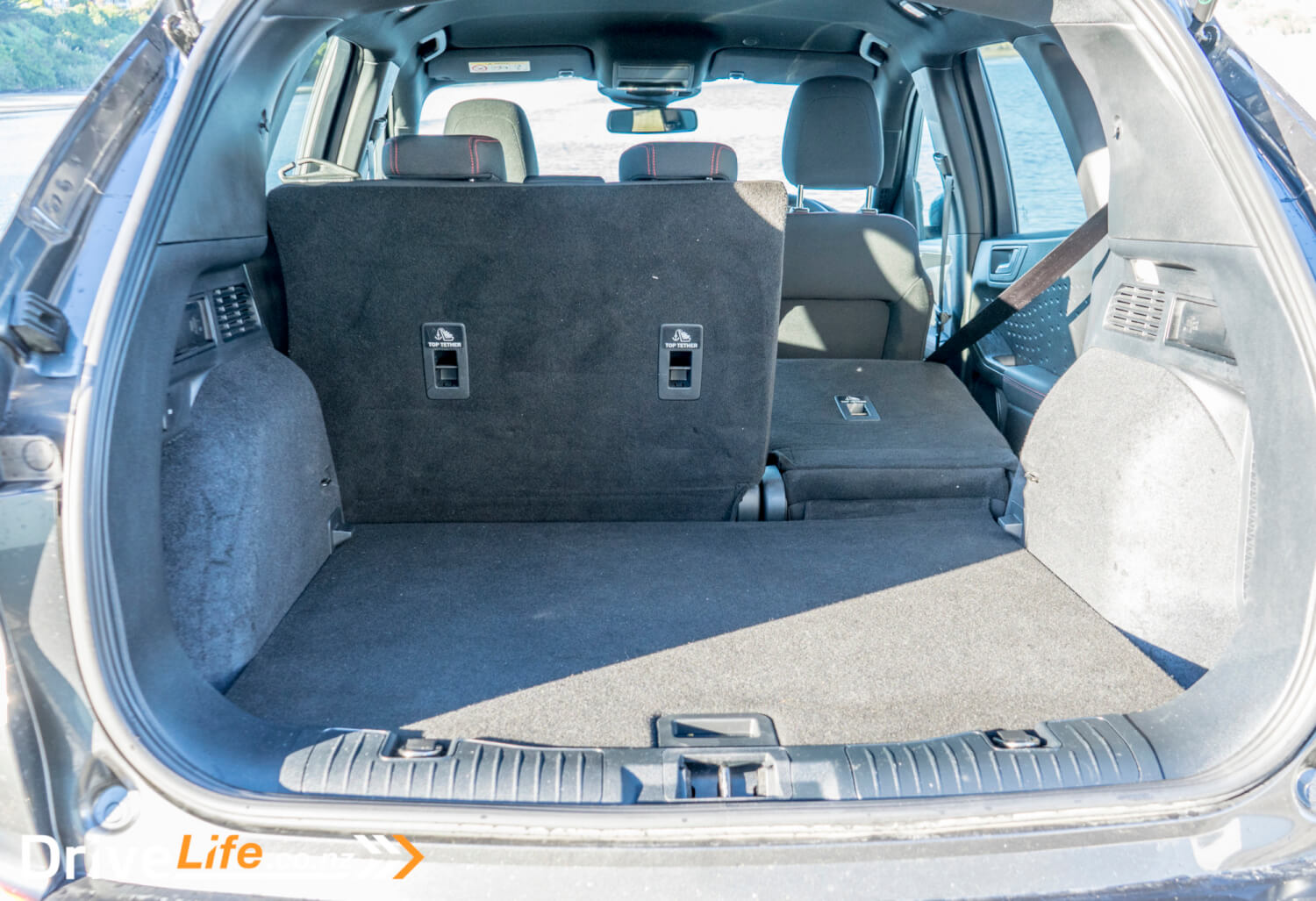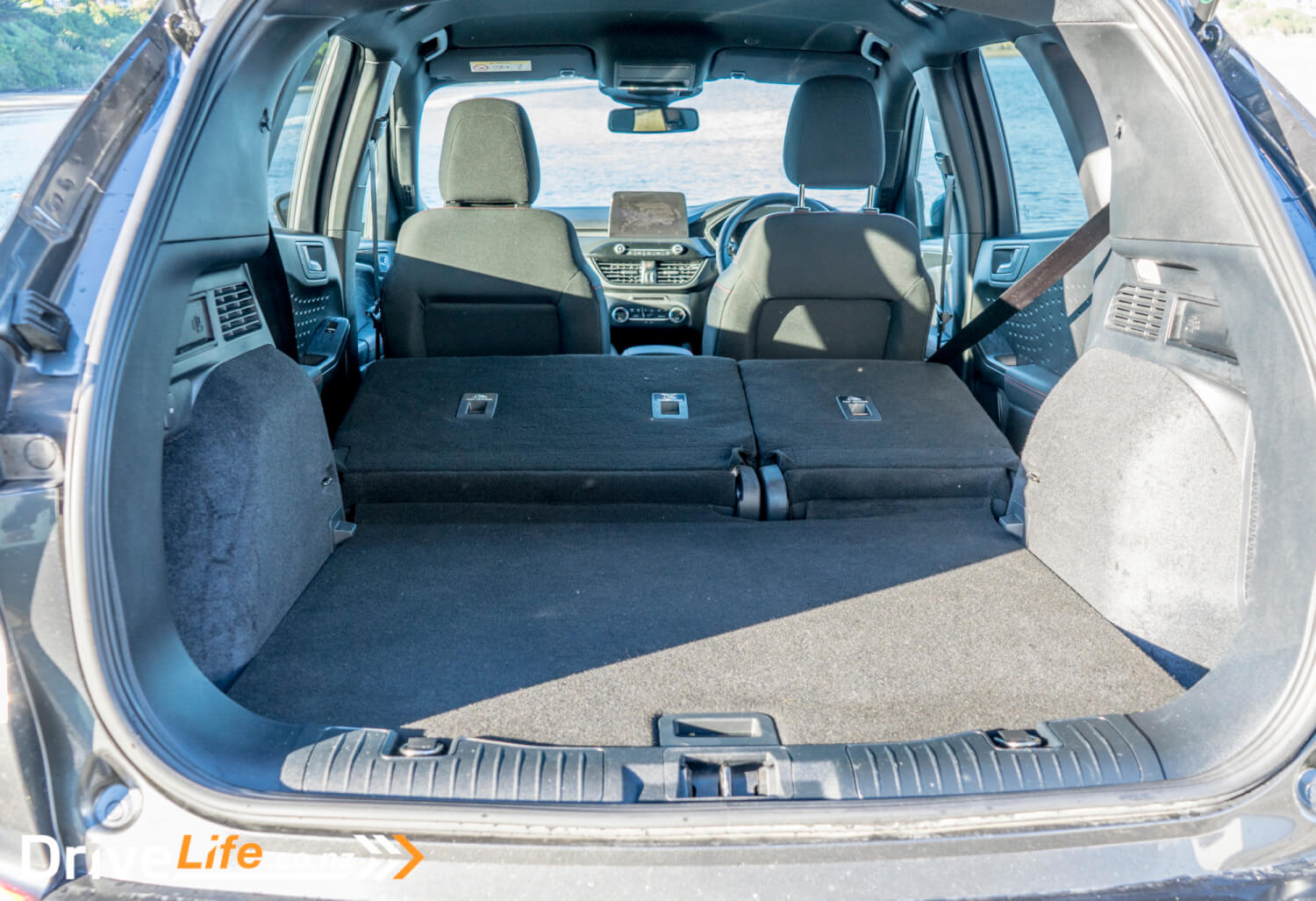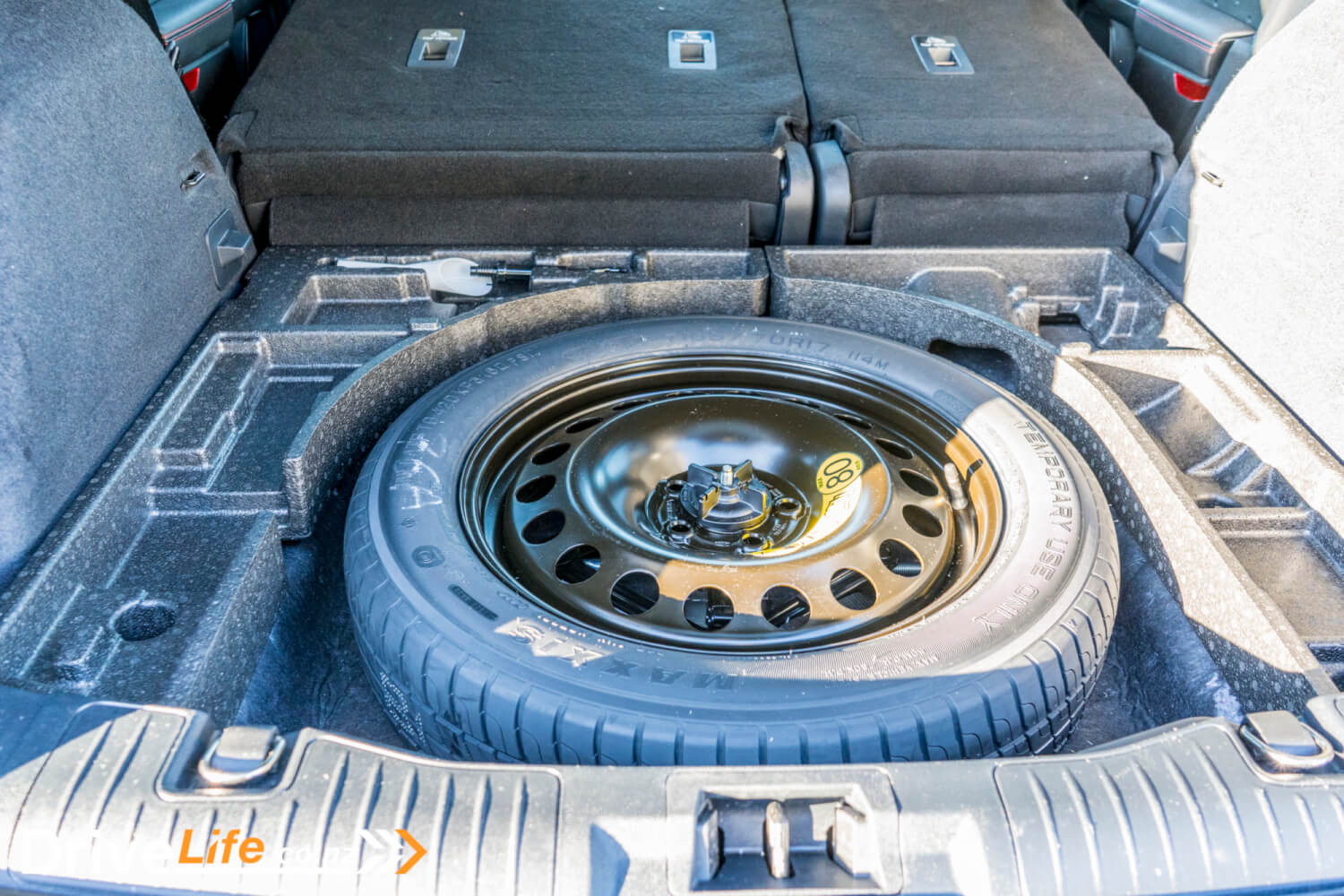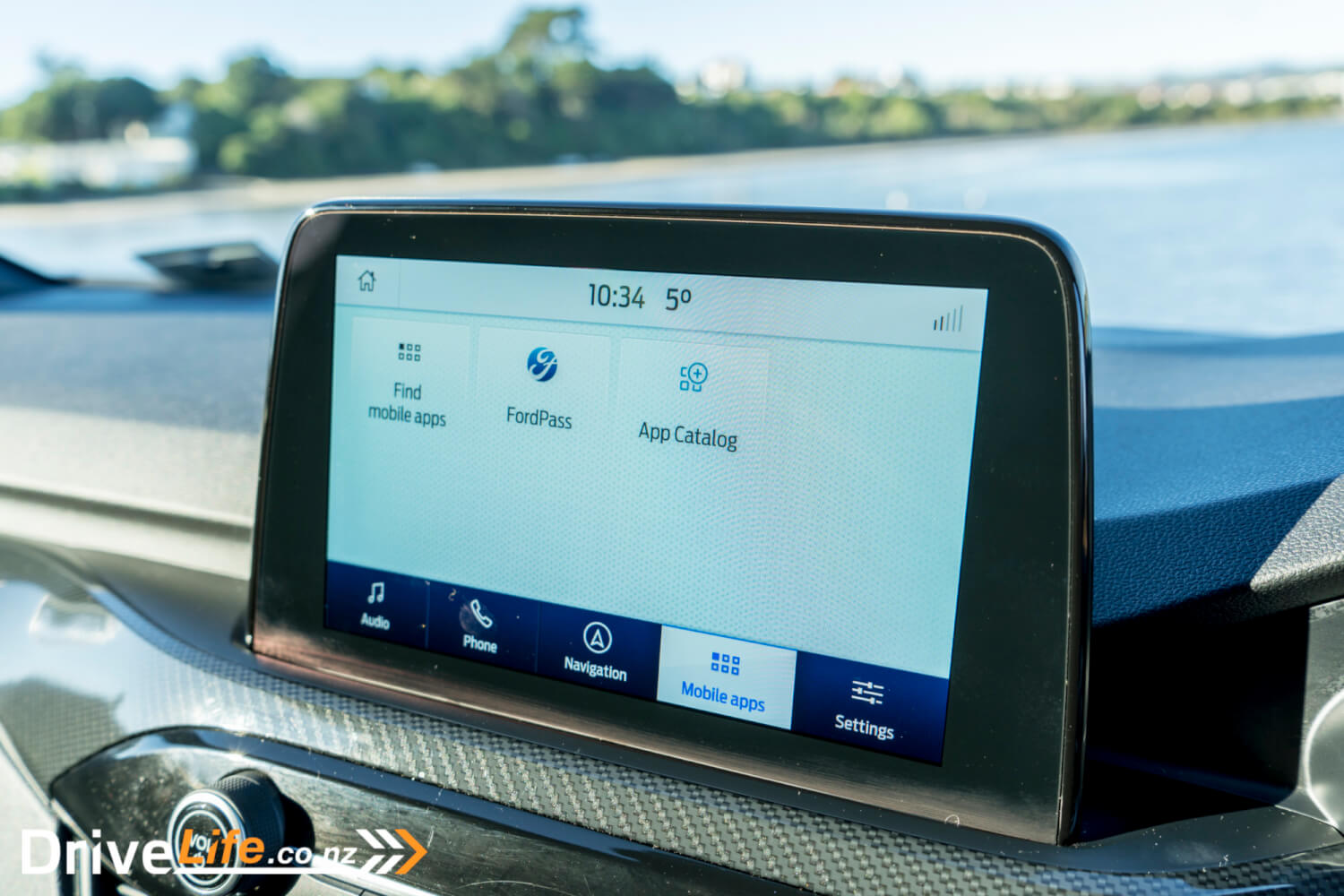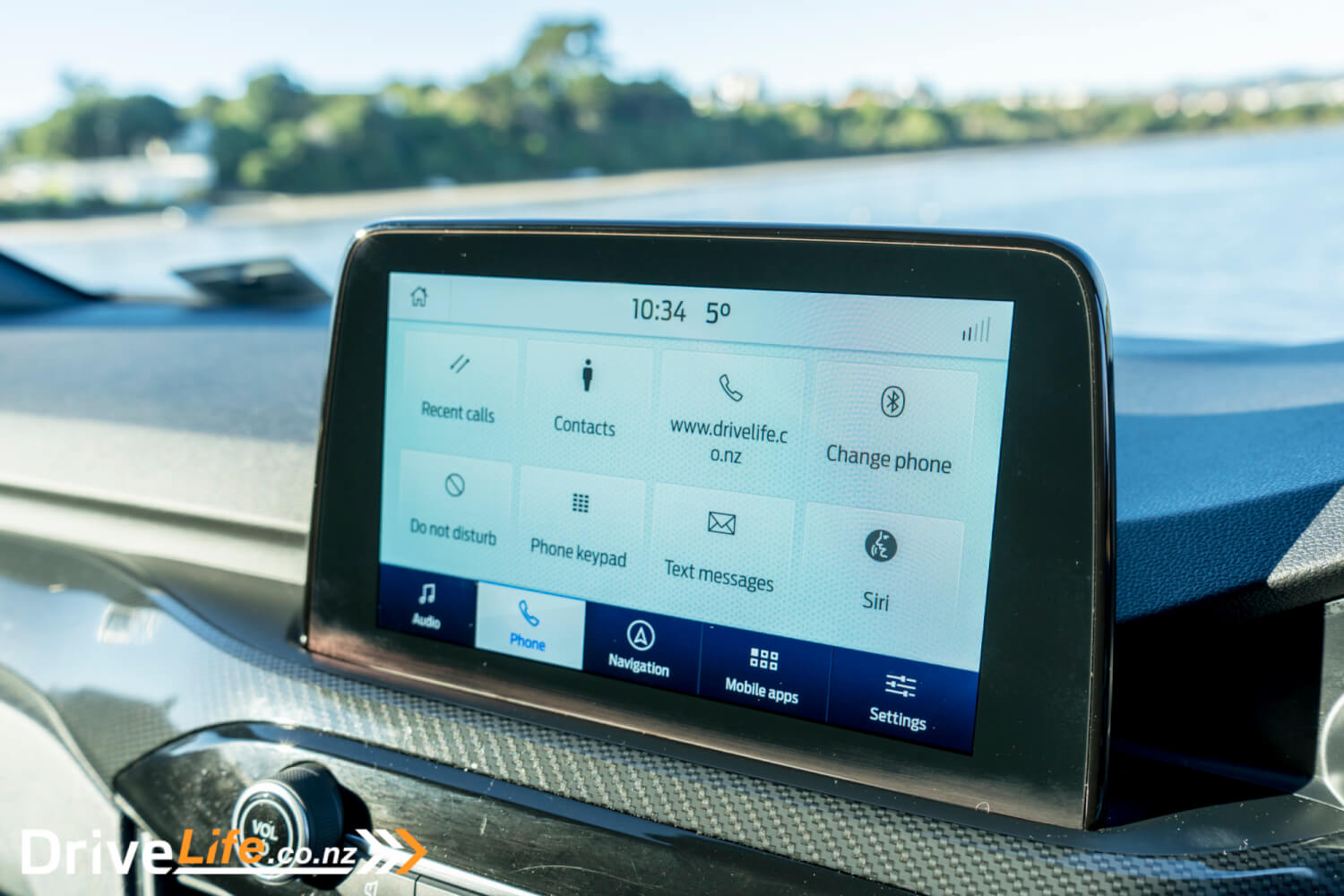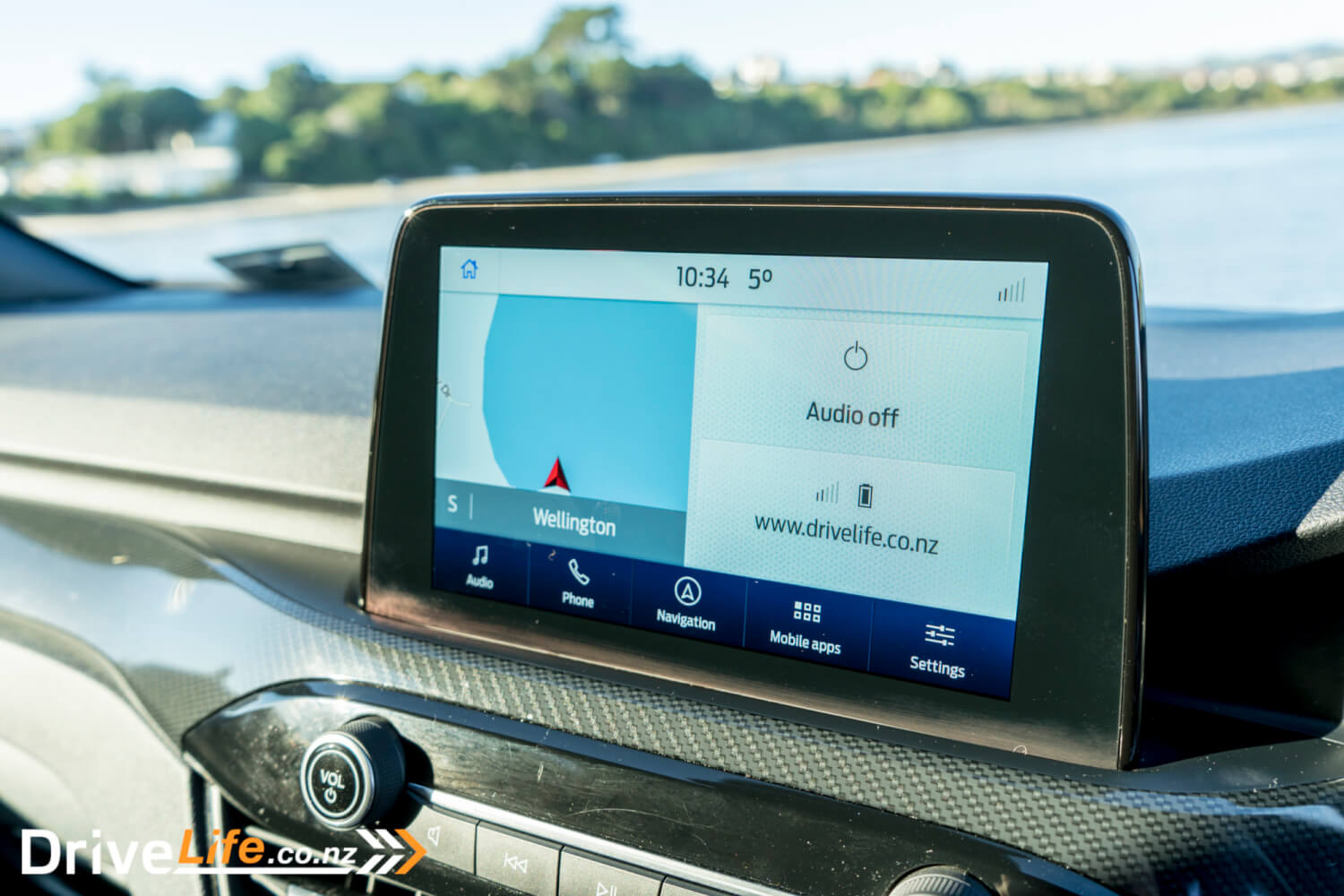In November 2020, DriveLife went to the launch of the 2021 Ford Escape. It came across as a smooth, grunty SUV that would sell well. Finally, we get behind the wheel for a few weeks, sharing the car between two reviewers to get an overall view of the Escape.
While we had this model on test, Ford announced the plug-in hybrid model (PHEV) would also be available very soon.
With such a huge range of choices in the medium-SUV segment, can the latest Escape keep its market share even with a PHEV model?
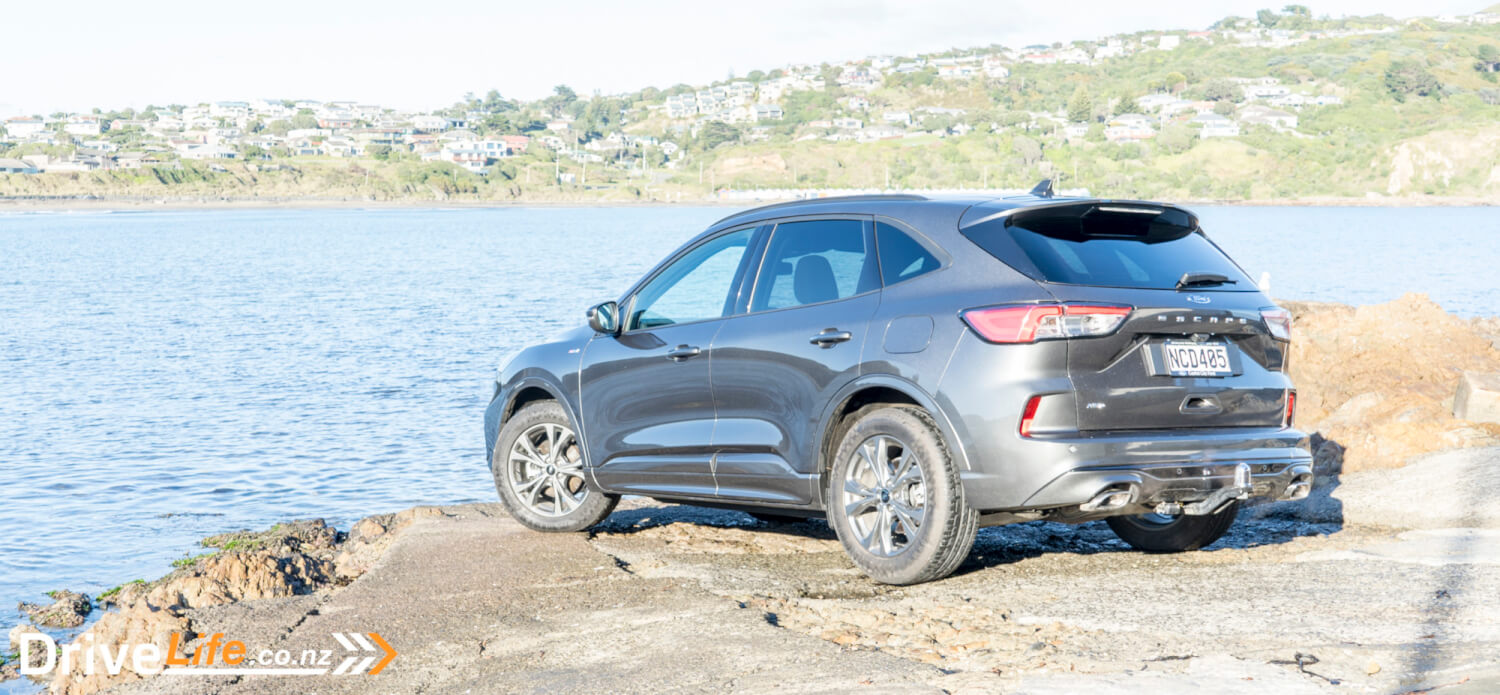
What’s In The 2021 Ford Escape Range?
With the recent introduction of a plug-in hybrid (PHEV) model of Escape, you now get to choose from 6 models. At the base end of things, there’s a front-wheel drive (FWD) Escape at $42,990, which comes standard with a 6-speaker sound system, an 8-speed automatic transmission with SelectShift, adaptive cruise control with Stop & Go, Apple CarPlay & Android Auto capability, Autonomous Emergency Braking (AEB) with Pedestrian and Cyclist Detection, Blind Spot Information System w/ Cross-Traffic Alert, LED reflector headlamps, Ford Pass Connectivity w/ Embedded Modem, a rearview camera, a rotary e-Shifter, and Qi wireless phone charging. This car is powered by a 2-litre, EcoBoost 4-cylinder turbo-petrol engine which puts out 183kW of power and 387Nm of torque.
There’s also a base model PHEV which starts from $60,990. It has the same equipment as the base Escape but is powered by a 2.5-litre Atkinson-Cycle engine and of course, has a hybrid powertrain.
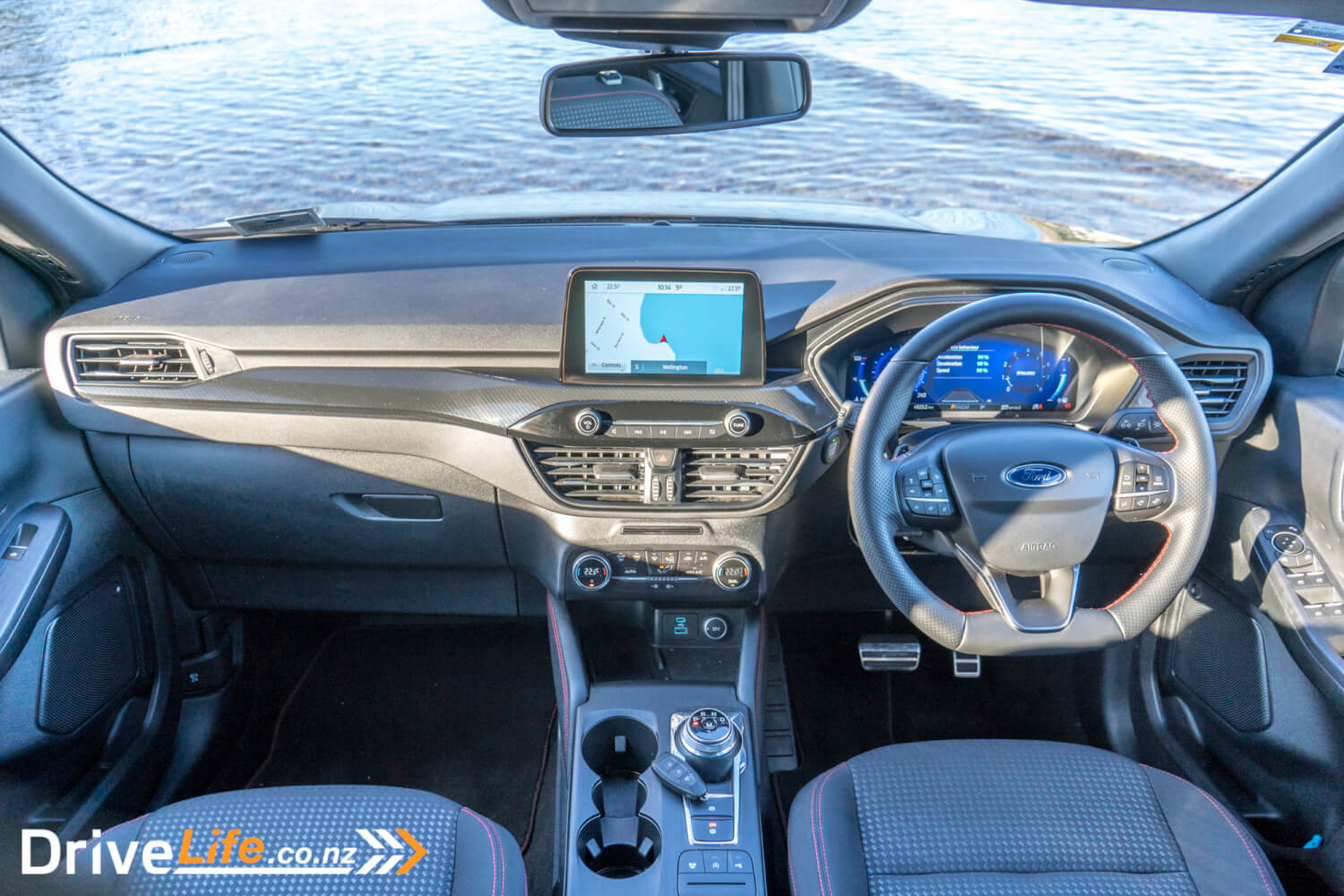
Next up is the ST-Line in either FWD ($47,990) or all-wheel drive (AWD) at $50,990, which is our test car. It has the same 2.0-litre EcoBoost engine and same transmission as the base model but adds automatic wipers, keyless entry and start, an ST-Line body kit, and a 12” full LCD instrument cluster.
At the top of the model range is the ST-Line X, in AWD if you buy the non-hybrid ($55,990), but only FWD for the hybrid ($66,990). Other than their different powertrains, extras over the other models include automatic parking, a B&O sound system, Quad Projector Dynamic Bending LED headlights, a panoramic sunroof, and a 180-degree split view reversing camera.
There’s not a lot of imagination in the colour selection for this car; Frozen White, Solar Silver, Blue Metalic, Rapid Red, Agate Black, Magnetic (which is another shade of grey).
You can read more about the Escape on Ford New Zealand’s website.
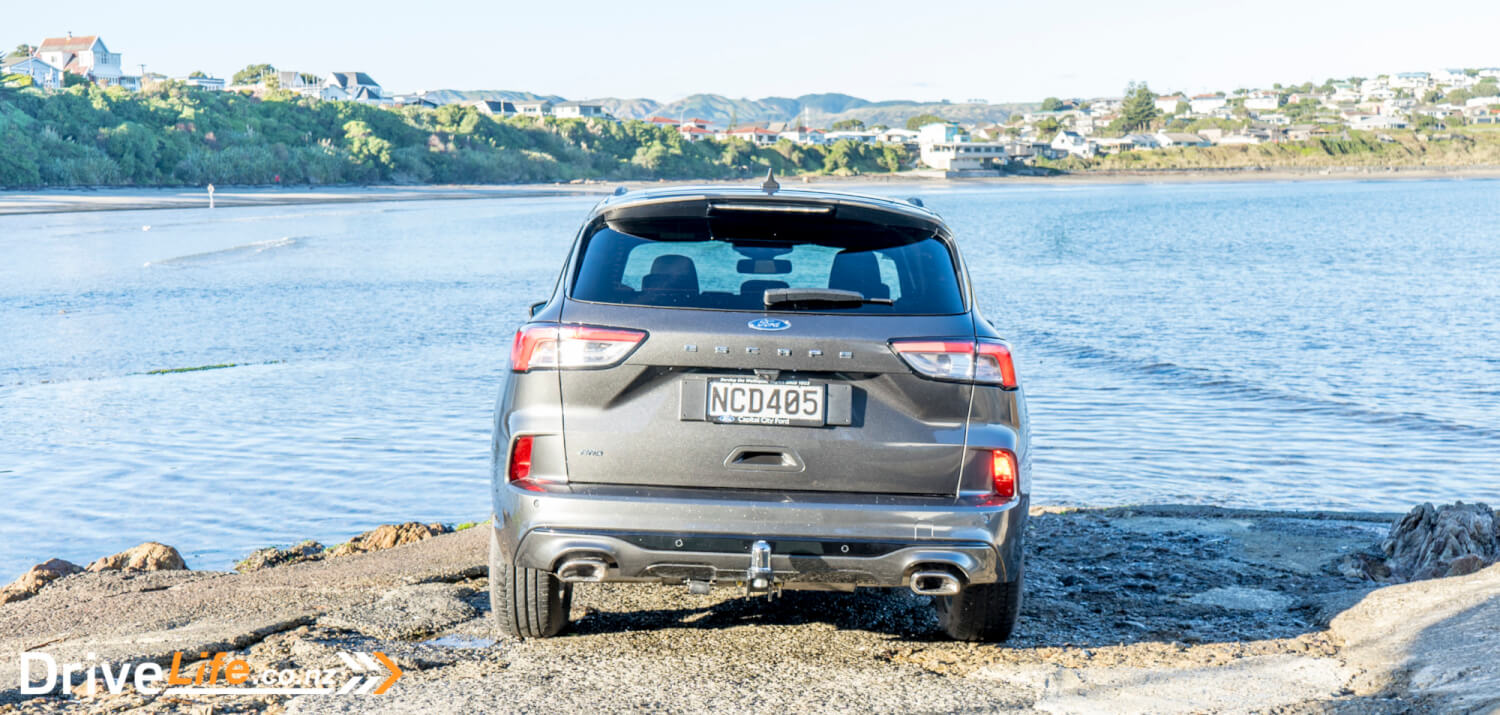
What’s Our First Impressions Of The 2021 Ford Escape ST-Line?
While it may be Ford’s hero colour for the Escape, the Magneto Grey our test car was finished in didn’t do it any favours. It’s still a nice-looking SUV, but it certainly doesn’t stand out from the crowd. Mind you, that’s what some buyers are probably going for.
The whole design is a big departure from the previous gen of Escape; it’s a lot smoother now, and has ultimately lost that boxy shape that some took as a sign of more cargo room. It looks a lot shorter than the previous model, but it isn’t.
To be honest, it looks like a Puma on steroids, but that’s not a bad thing. I liked the shape, I felt it was nicely executed and inoffensive, but others felt it was a bit meh when finished in dark grey.
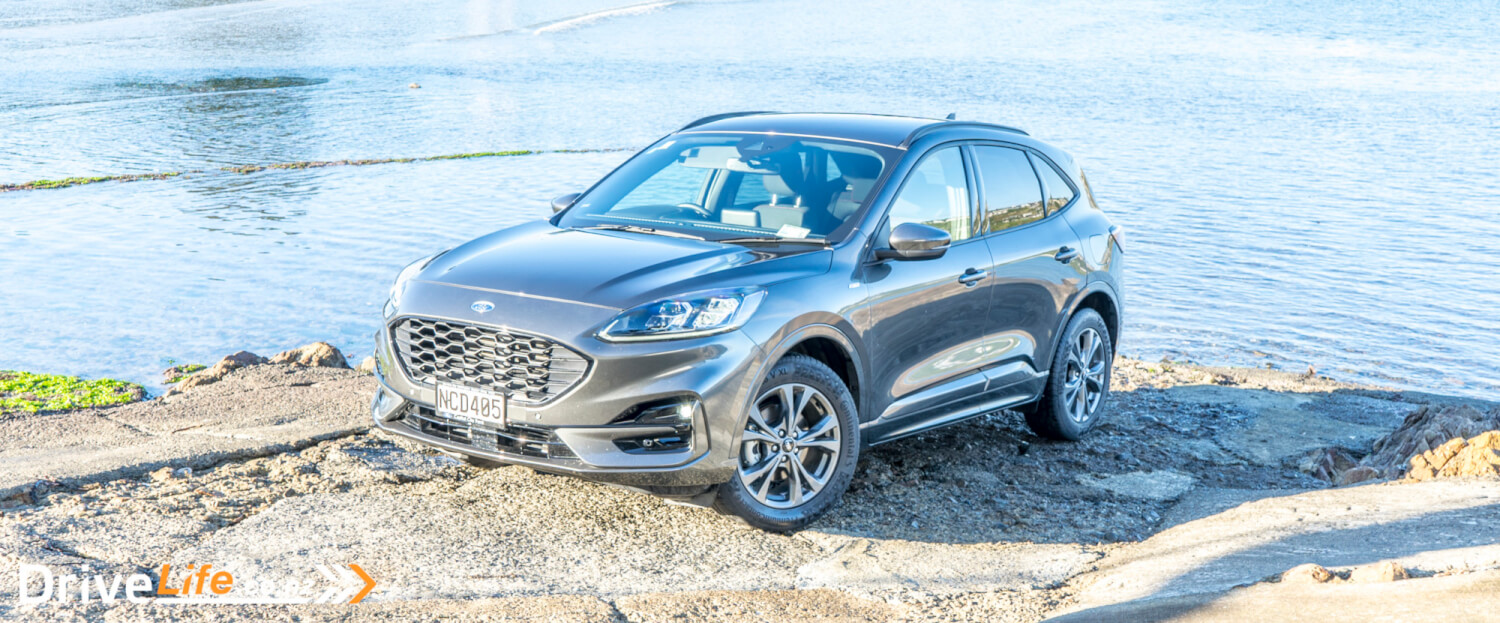
What’s The Interior Like On A 2021 Ford Escape ST-Line?
There’s yards of blackness on the inside of the new Escape, at times making it feel a bit cheap. This view is helped along by lots of hard black plastic, but on the positive side of things Ford have used contrasting red stitching on the doors, console, steering wheel, seats and doors – so that helps lift things quite a bit. All seating is black, as is the headlining. Such a missed opportunity; a beige or ivory headlining would have made all the difference.

Up front, there’s a flat Qi wireless flat phone charging pad with raised edges, and I certainly didn’t have any issues with my phone sliding about and losing connection with the pad. Next to the Qi charge pad is both a USB-C and a standard USB charging port (also used for audio) and we’re seeing more of this lately. Having both ports is a nice way to cover all your bases, so thanks, Ford. There’s also a 12-volt socket for your dash cam.
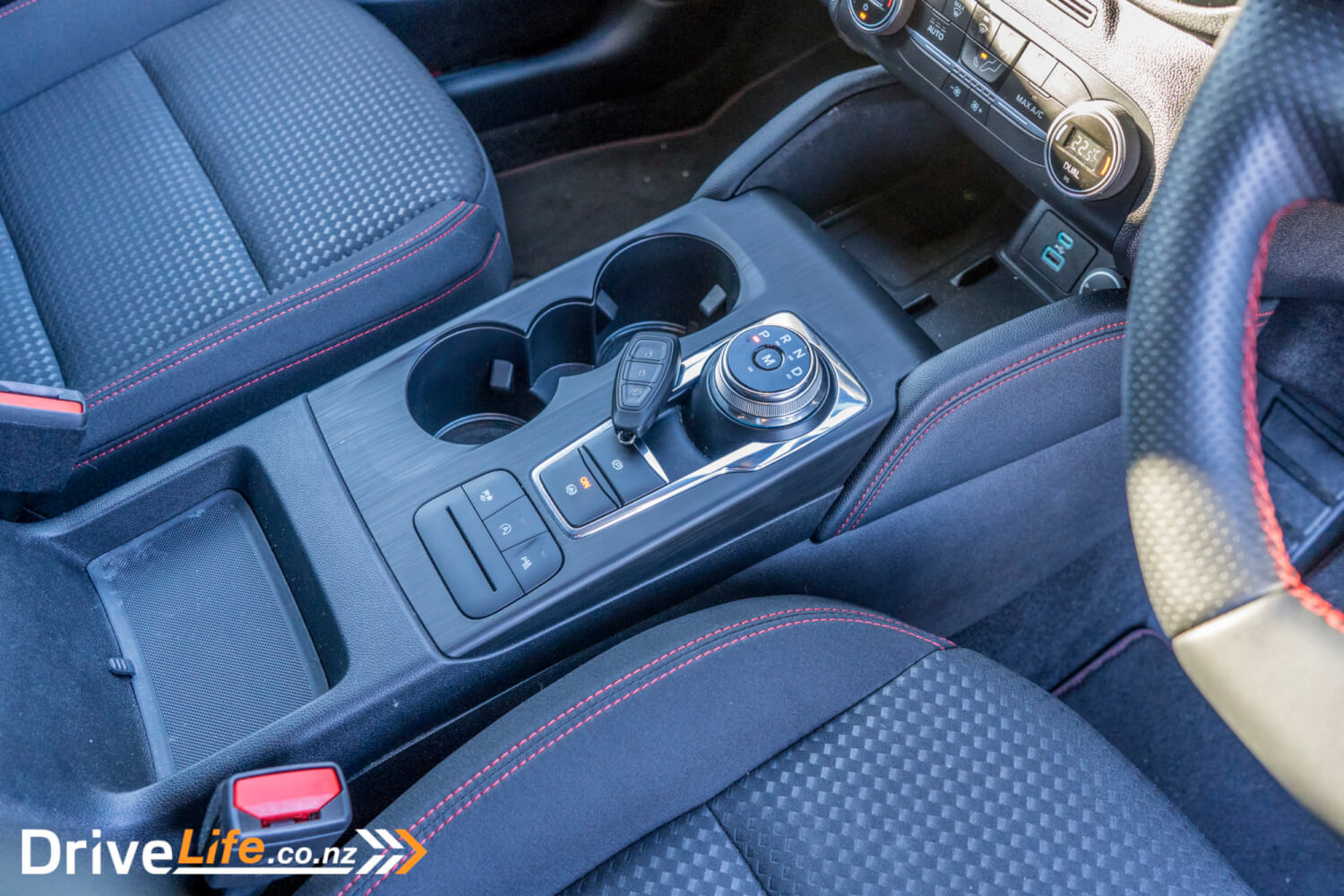
During my time in the Escape, we did have a very cold snap so I was pretty disappointed that at $51K, this Escape ST Line does not have heated front seats. It seemed a really odd omission at this price point. You have to go to the top-spec ST-Line X at $58K if you want to keep your butt warm.
Likely the biggest change on the inside for current Escape owners would be the rotary gear knob. It doesn’t pop up out of the centre console for use (thankfully) so just sits there waiting to be twisted. It’s pretty easy to get used to, but going between Drive and Reverse and back again for parking can be a bit painful. There can also be a bit of a pause when selecting a gear, which can be embarrassing when you are trying to get into a car park and stop holding up traffic. Still, it looks pretty cool and eases up some centre console real estate. Pushing the centre button of the rotary dial will stick the car into Manual mode, where you can use the steering wheel paddles to control gears.
Typical of Ford, the cup holders in the centre console are illuminated, one of their trademarks. It’s a bit gimmicky, but a nice party trick for the kids.
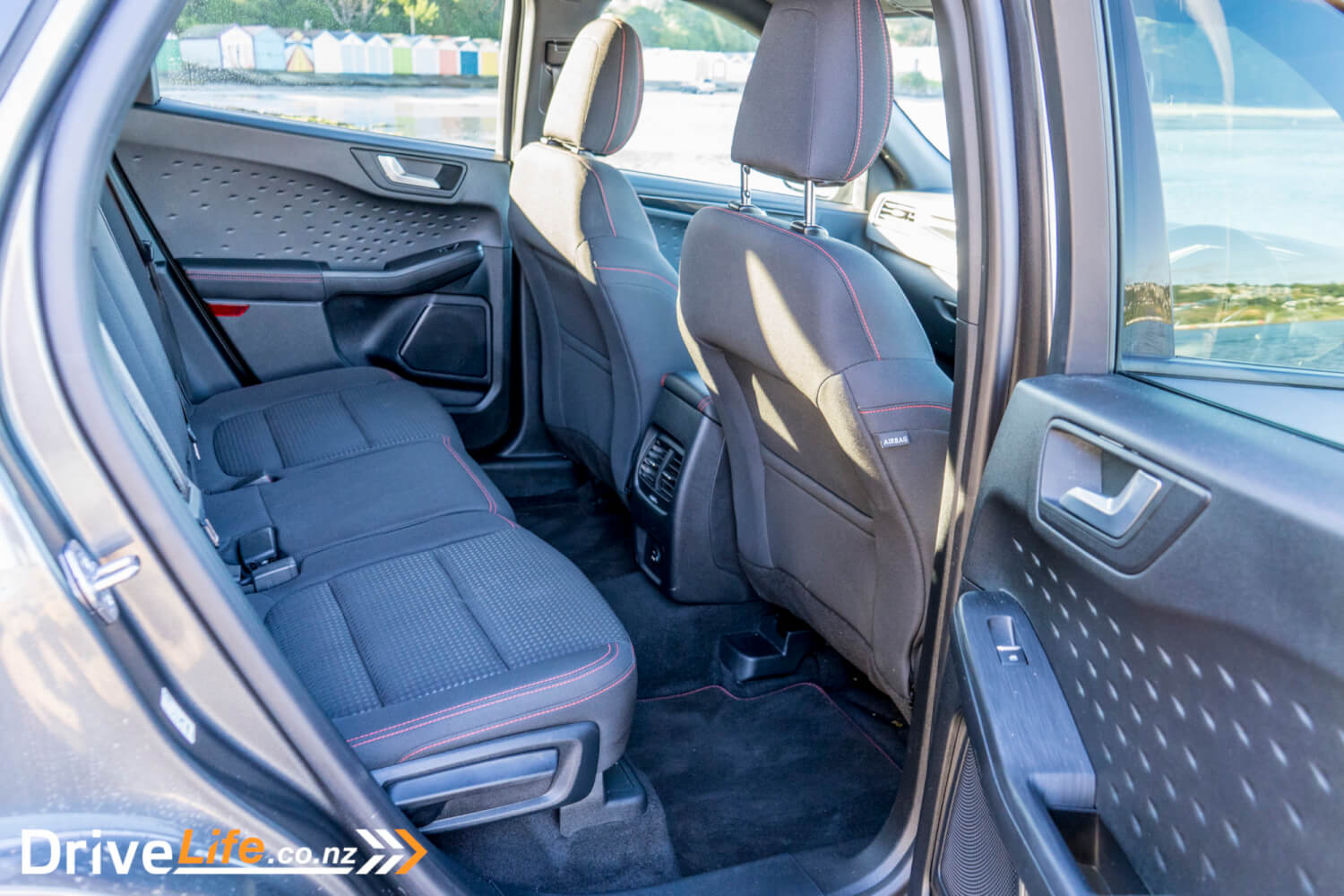
Rear seat passengers get a good amount of legroom and headroom, and the seats themselves are pretty comfy – up there in comfort levels with the front seats. The 2021 Escape does have quite a high waistline and so the side windows are on the smaller side, but at least the seats aren’t too low. Hopefully, this would keep the kids who get carsick on the non-vomiting side of things. The rear seats slide, so if you have more stuff to carry and passengers with shorter legs, extra space can be had in the boot.
The boot is a very reasonable size too at 556 litres. There’s a 12-volt socket back there which could be handy, as well as a space saver spare under the floor cover.
As is the current trend, instead of a hard parcel tray cover, the Escape has a soft cover which clips into place. We’ve generally found these to be quite good, giving you some flexibility of covering stuff in the boot without a hard cover getting pushed up and out of shape. But the soft cover in our test car kept falling down, as the push-clips that hold it onto the rear door weren’t strong enough. Mind you, I don’t know what sort of life our test car has had over the last 5,000Km.
What Does The 2021 Ford Escape ST-Line Drive Like?
The 2021 Ford Escape has a little more power than the previous petrol model, and this has injected the car with pretty surprising performance. I guess that shouldn’t be too surprising; with 187kW of power, the Escape is not that far off Hyundai i30N or Honda Civic Type R numbers. It has more power than the GR Yaris. Torque is impressive too, at 387Nm, and many buyers will be very happy with the way the car drives.
It’s smooth, generally refined, and on the whole the transmission behaves well. Motorway driving is a quiet affair, and there’s the knowledge that you have plenty of power at your right foot if you need it in a hurry. And that’s just talking about driving it in Normal mode; stick the car in Sport, and it’s even more eager to please. The gauges turn to red in Sport mode, and the rev counter gets bigger too. I didn’t feel any other changes with the car, it didn’t seem to firm up the steering or ride more firmly, but the noticeable change was in the engine’s character.

I was happy that Ford sent us the all-wheel drive (AWD) version; I drove the front-wheel drive model at the launch, it was a bit of a handful. It would not be a good car for a learner driver, as with that much power the chances of wheelspin at any time are pretty high. The AWD is great in getting all that power down.
You would think that would mean driving the car in Eco mode would be a doddle, and you’d be right. It’s pretty happy driving around everywhere in Eco, with so much torque it handles it easily. A shame the car forgets what drive mode you were in when you get out, and reverts back to Normal on every start.
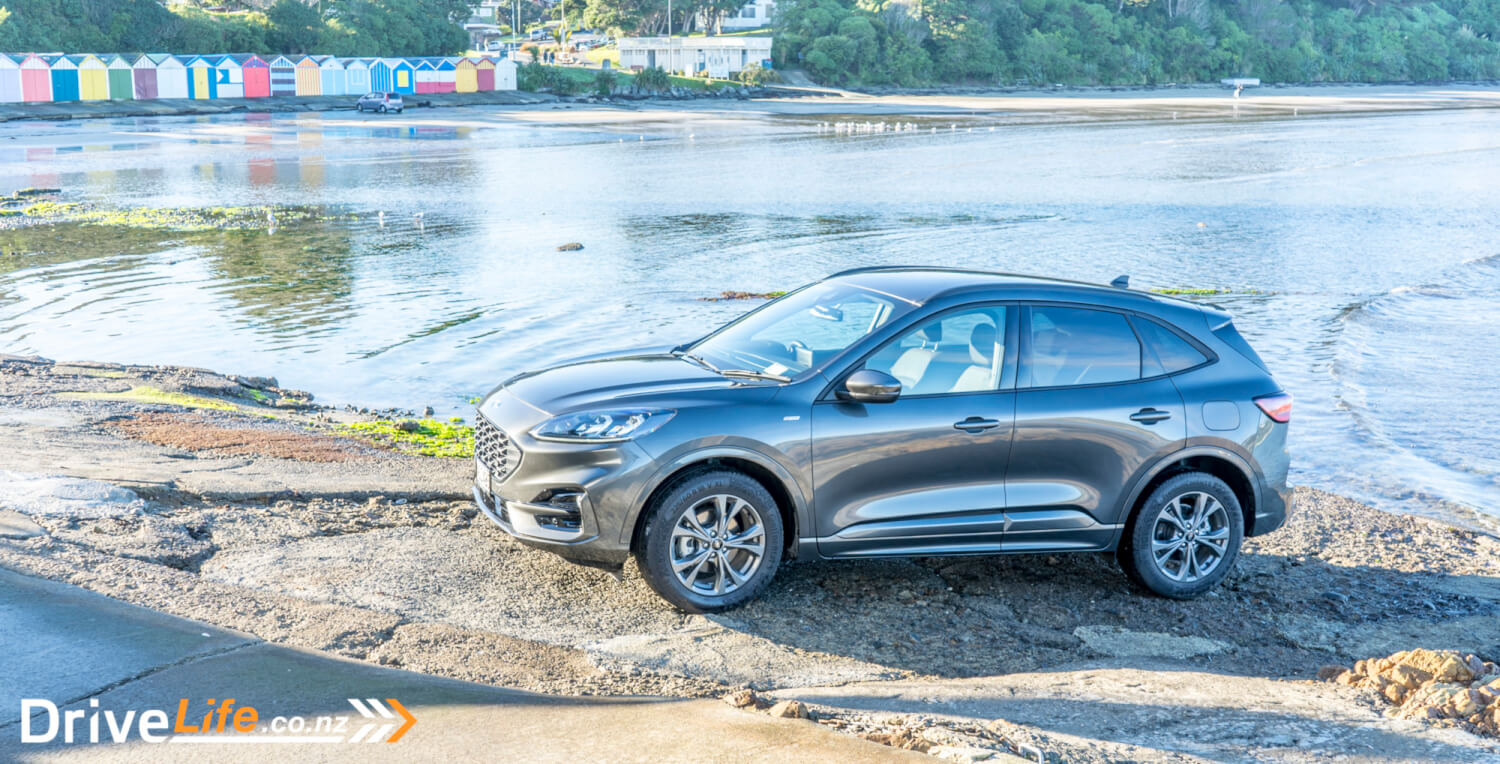
I say “generally refined” and also that on the whole the transmission behaves well, as at low speeds sometimes you can feel the transmission being a bit indecisive, and there can be some jerkiness in the drivetrain at lower speeds. It’s not bad, and it’s far better than most dual-clutch automatics, but with the engine being so smooth at revs above 1,000rpm and the transmission being so good at any other speed, it stands out. Not really a black mark, but if it were smoother at low speeds, it’d be perfect.
Handling isn’t a strong suit of this Escape, it doesn’t like to be pushed too hard and the steering can feel numb, with little feedback coming from the front wheels. This isn’t what it was made for of course, but with more than a few SUVs now being quite competent in the handling department, the Escape has been left behind here a little. Still, most people won’t notice this because they’ll be using the car every day for their life’s activities.
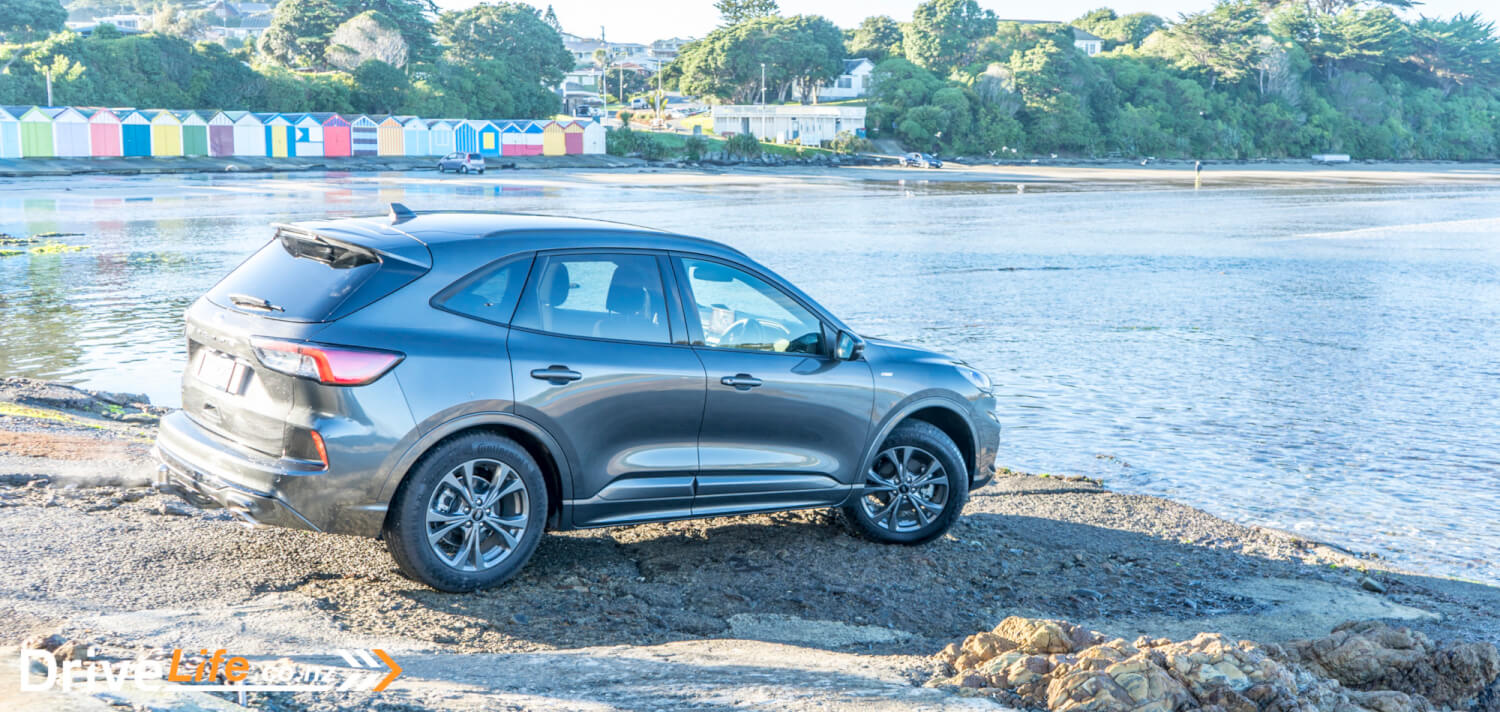
If you are using the Escape for your Daily Driver, there’s some pros and cons. The ST Line has adaptive cruise control, supposedly with ‘Stop and Go’. But it’s not the true ‘go’ that we are used to with more expensive brands. The Escape will bring the car to a stop under adaptive cruise control, but when you want to go, sometimes you’ll need to tap the Res button on the steering wheel, or tap the gas pedal, which is the same as every other car with adaptive cruise. It seems dependent on how long you are stopped for. True Stop and Go adaptive cruise means the car moves off by itself if the traffic in front moves away.
Adaptive cruise means you can use lane keep assist, and at very low speeds (e.g. a traffic jam) there isn’t the requirement to keep your hands on the wheel, meaning a stress-free way to traverse a lot of slow moving traffic. Of course, you’d never drive with both hands off the wheel. I did like that when using adaptive cruise, the driver’s information display would show you if it was following another car, and occasionally would show me a Mustang, even if it wasn’t one (it never was). It felt like an “if only you had worked a little harder” scenario, but I liked the special touch.
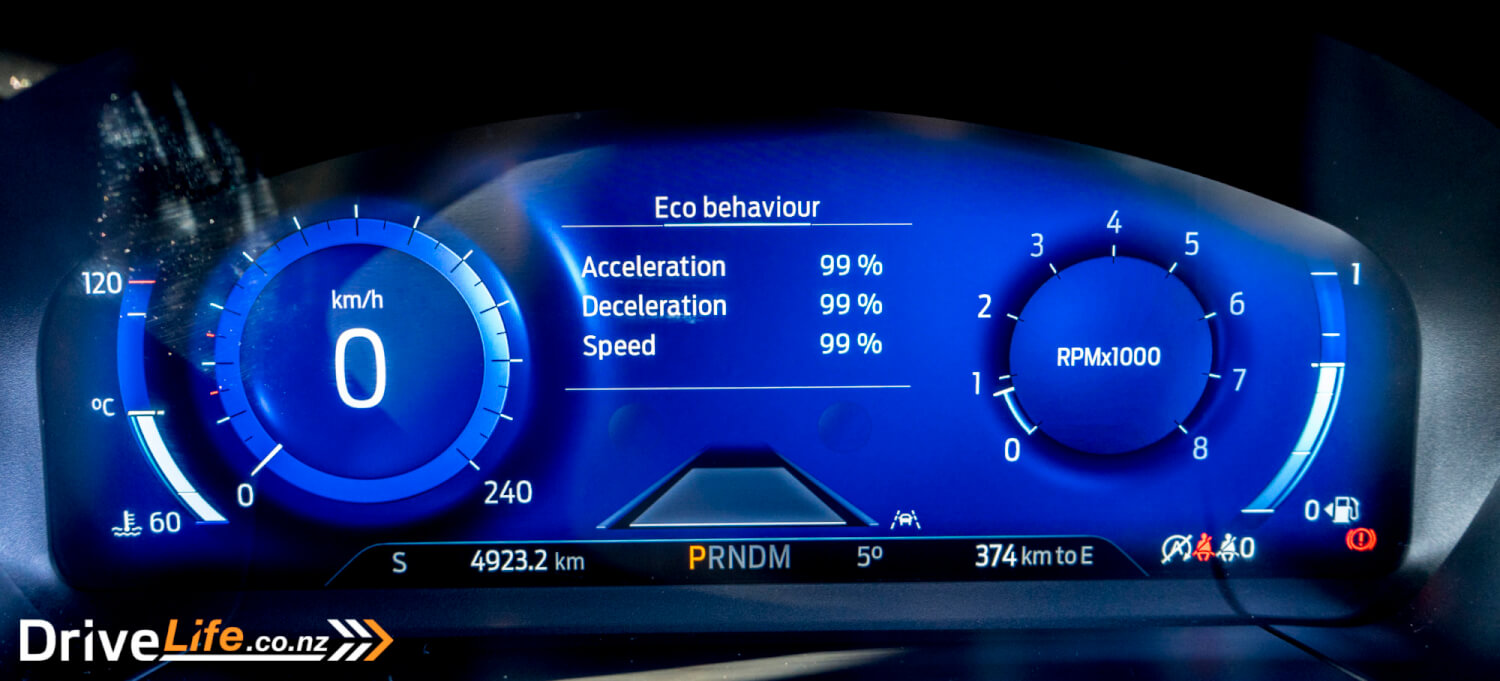
This model doesn’t have a 360-degree camera system, but front and rear sonar is in place meaning that in a tight carpark (for example) the central display will start beeping and show you what you are close to and where, with warning lines going from orange to red if you get really close. It’s the next best thing to a 360-degree camera system and I found it really handy on the day-to-day drive.
Speaking of the central display, it’s nicely done – crisp and clear. There’s a slight lag between screens, but it’s not bad at all. SatNav is standard, and turn-by-turn instructions are shown in the driver’s information display, and that’s always appreciated. There’s clear lanes shown so you can see exactly which lane you are supposed to be in on the motorway. One glitch – and one we saw on a Honda’s CR-V, was that when heading north on SH1, the SatNav tried to get us to take the Transmission Gully route. Of course, that road isn’t finished yet. The temptation was strong (“but officer, I was just following the GPS”) but my wife’s opinion prevailed, and we stuck to SH1. Boring.
Visibility is on the okay side of thing; that chonky A pillar can impede your vision, and the B pillar is pretty fat too – all in the name of safety. There is blind-spot monitoring to keep you safe, though.
The 2021 Escape’s dashboard doesn’t have much customisation on the ST Line; actually, it has none, but you can select from different views, like trip meter, an eco gauge, traffic signs etc. The traffic signs one shows the current speed limit as it goes past a speed limit sign, but after not too long this disappears. It would make more sense for it to simply keep the speed limit sign there so you are always aware, so I’m not sure of the thinking behind this. Speaking of Traffic Sign Recognition (TSR), I’ve got to say it’s not too reliable in this car. It often got it wrong, to the point where I simply didn’t believe it.
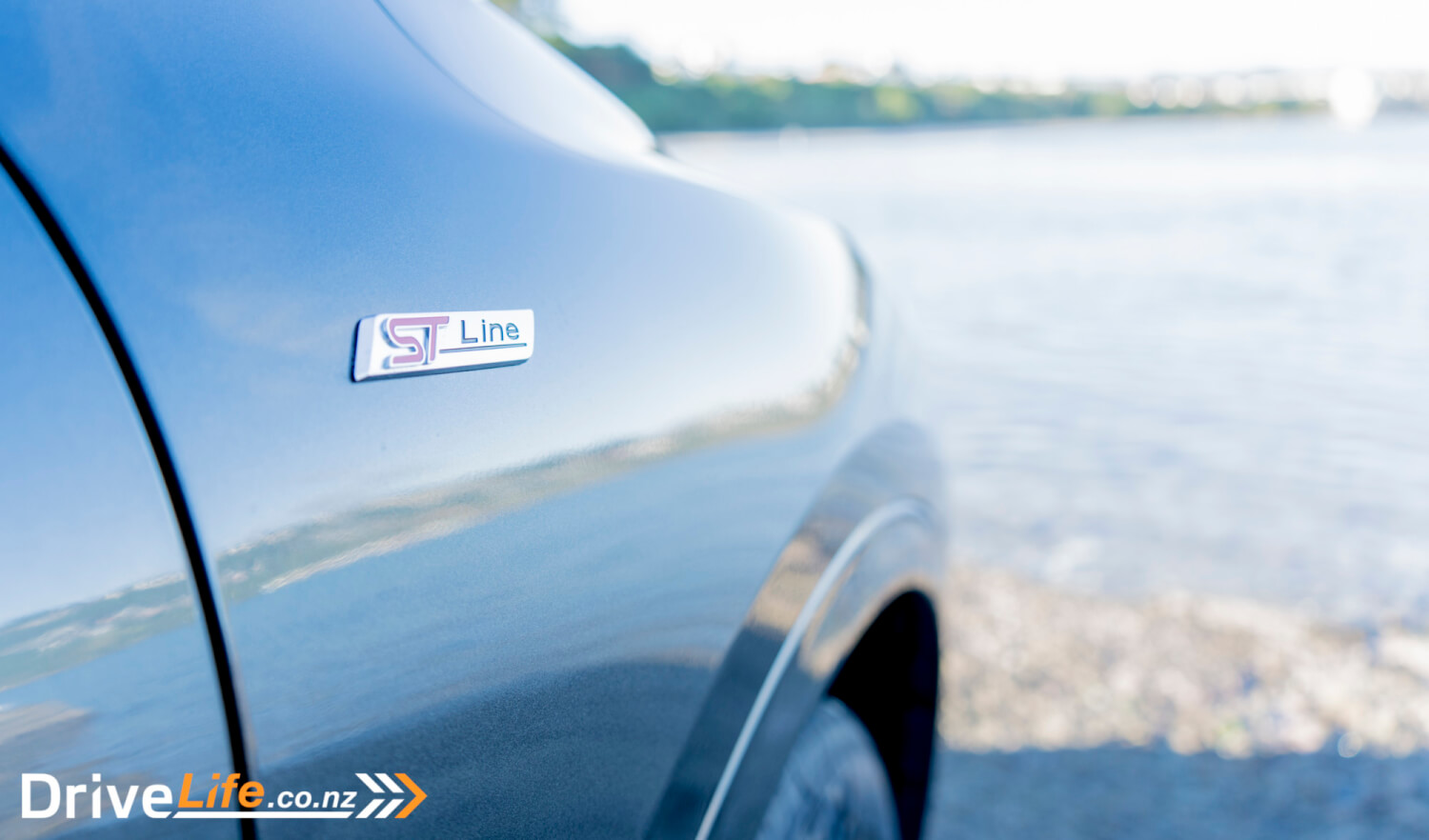
On the plus side of things, happily for me, brake auto-hold stays on when you get back in the car, which is a feature I love to use. It adds a new level of safety to your driving experience. The headlights are awesome, self-levelling and LED. They’re not adaptive, but they throw out a lot of usable light. Top marks for these headlights. I was happy to see that all the windows are auto up/down, a feature that is always welcome.
If I were to complain a bit about other things, the audio is pretty flat, and a song with too much bass will see the doors vibrating. There is some tyre noise on coarse chip seal, but generally it’s bearable, and common for the Continental Premium Contact 6 tyres fitted to our test car.
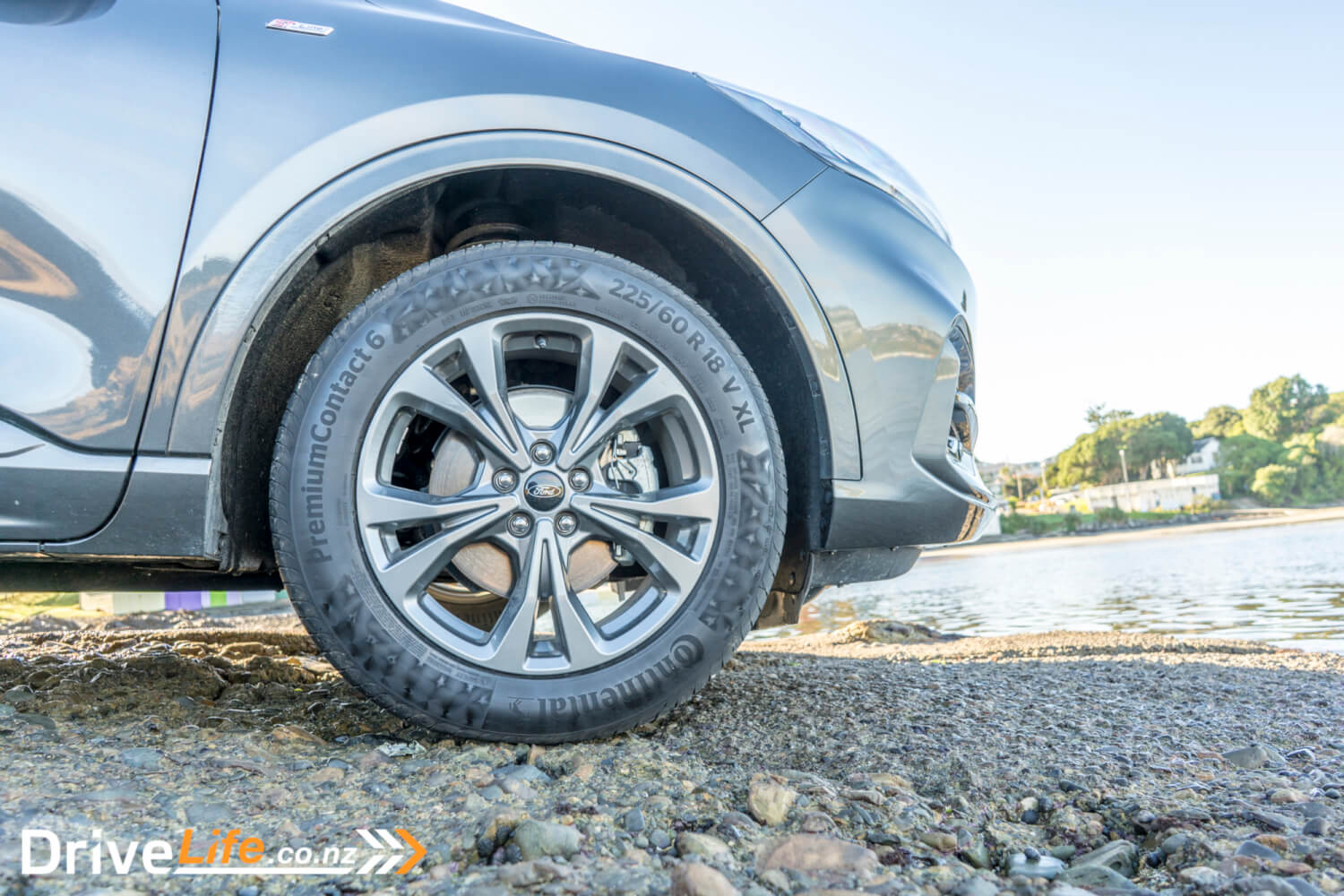
Fuel economy was better than expected, at 8.4L/100km over 600Km of a decent mix of around town and motorway travel. For a 2-litre turbo petrol with 187kW of power, that’s a very reasonable return. Surprisingly, this is better than Ford’s suggested figure of 8.6L/100km. That’s a rare occurrence when we beat a manufacturer’s figures.
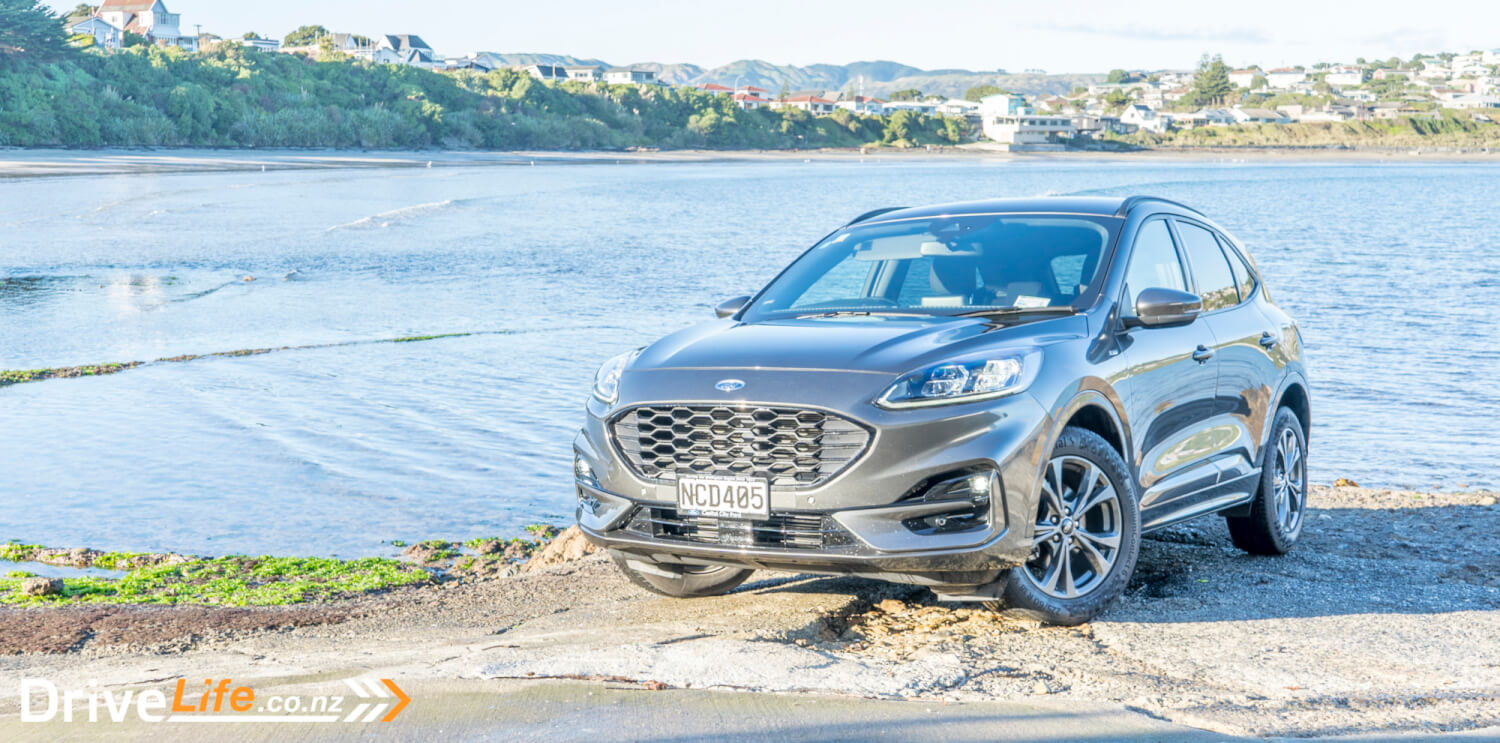
ALISTAIR’S POINT OF VIEW
When you’ve had the luxury of driving many cars, you’re regularly exposed to all of the latest and greatest (and sometimes not-so-greatest) technologies finding their way into new vehicles.
Some of these tech advances are impressive, yet, they’re quite irrelevant when the basics of a car aren’t done right. It sometimes feels like the manufacturers can occasionally lose sight of the basics when they’re busy thinking about the font type for the digital dash cluster.
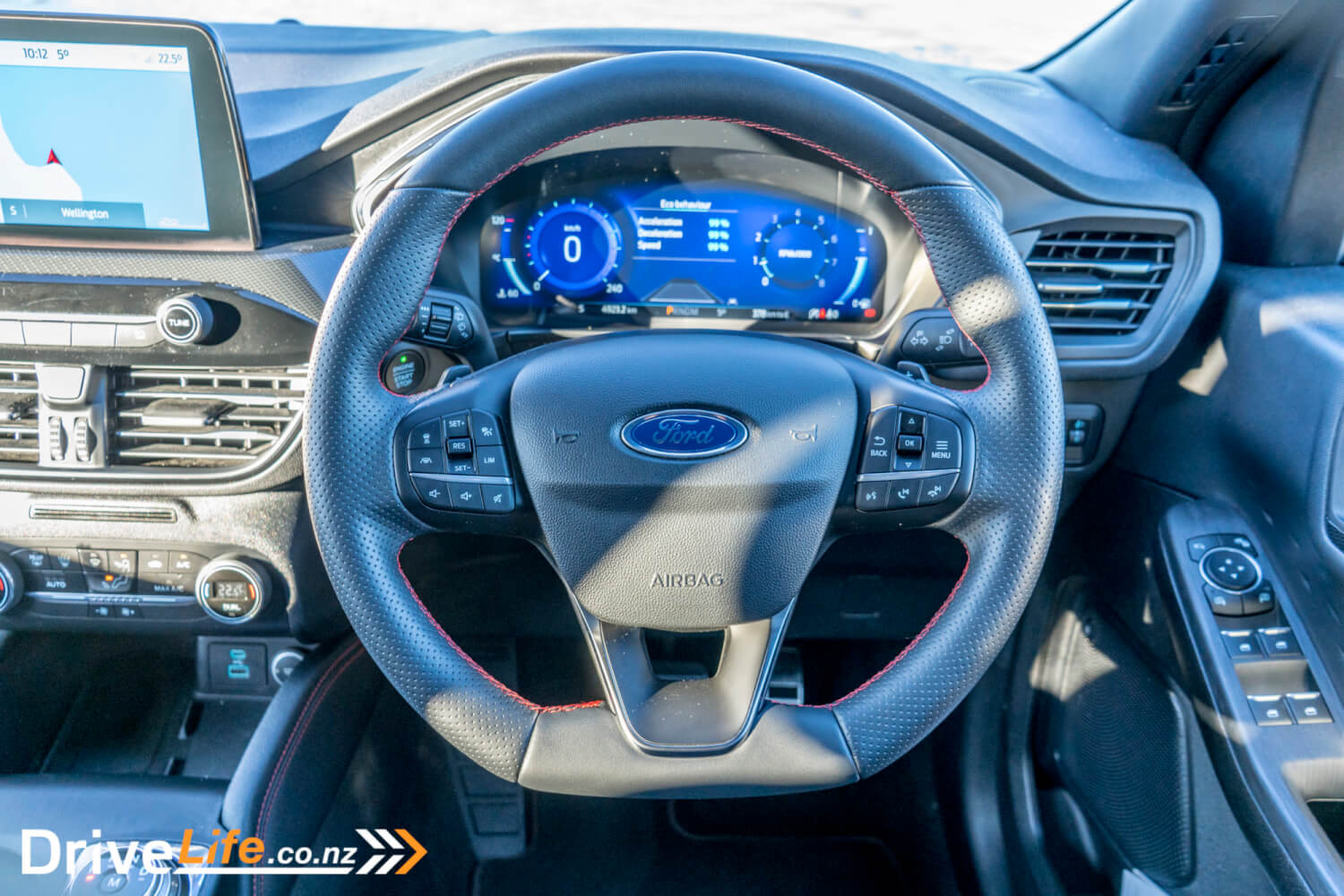
The Ford Escape was a refreshing example of the basics being done well, with the right amount of technology.
Jumping inside for the first time, I was already impressed. The interior was spacious, and the ergonomics were excellent. The seats were supportive, the steering wheel pleasant to touch, and importantly, there were obvious storage spaces for your wallet and smartphone.
The performance of the ST-Line’s 2.0-litre turbo engine is great. Push the right pedal further than necessary, and the Escape doesn’t sit around. It’s pretty darn brisk, and it’s incredibly well-refined too. Honestly, it’s so pleasant to drive a mid-level crossover with some power for once.
On the tech front, the Escape has all the latest toys. Sometimes these toys can be invasive on newer vehicles. Fortunately, Ford has the gumption to make sure they’re mostly tuned correctly, which is another big tick for the general liveability of the Escape.
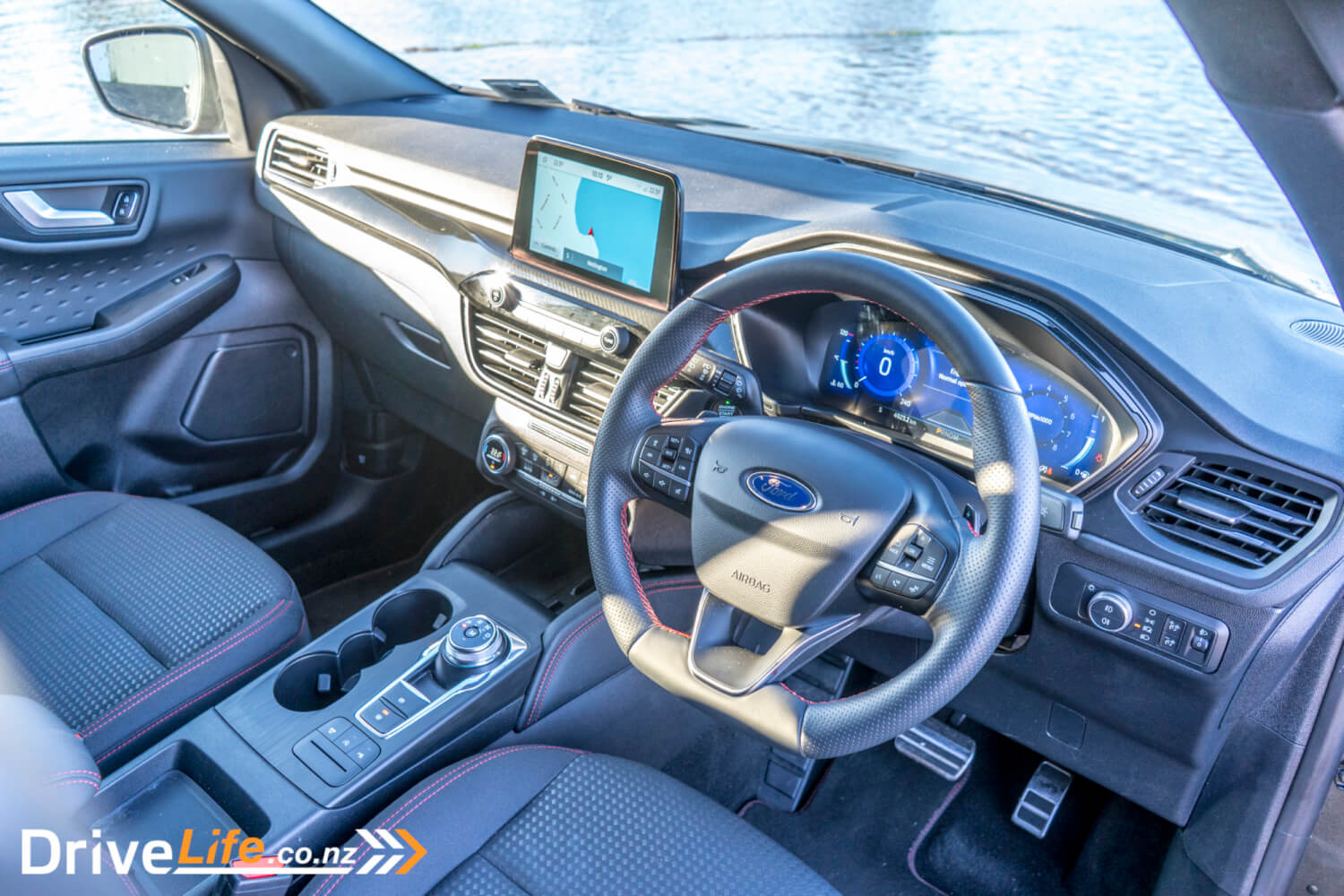
In my test of the Escape, there were only two issues that stood out to me.
The first issue is the chassis composure and ride quality. If you’re merely plodding along city streets, it’ll mostly feel fine. However, the chassis dynamics simply don’t keep up when the 2.0-litre turbo engine starts stretching its legs. There’s a real feeling of inertia through a quick corner, and the body moves around a fair amount too.
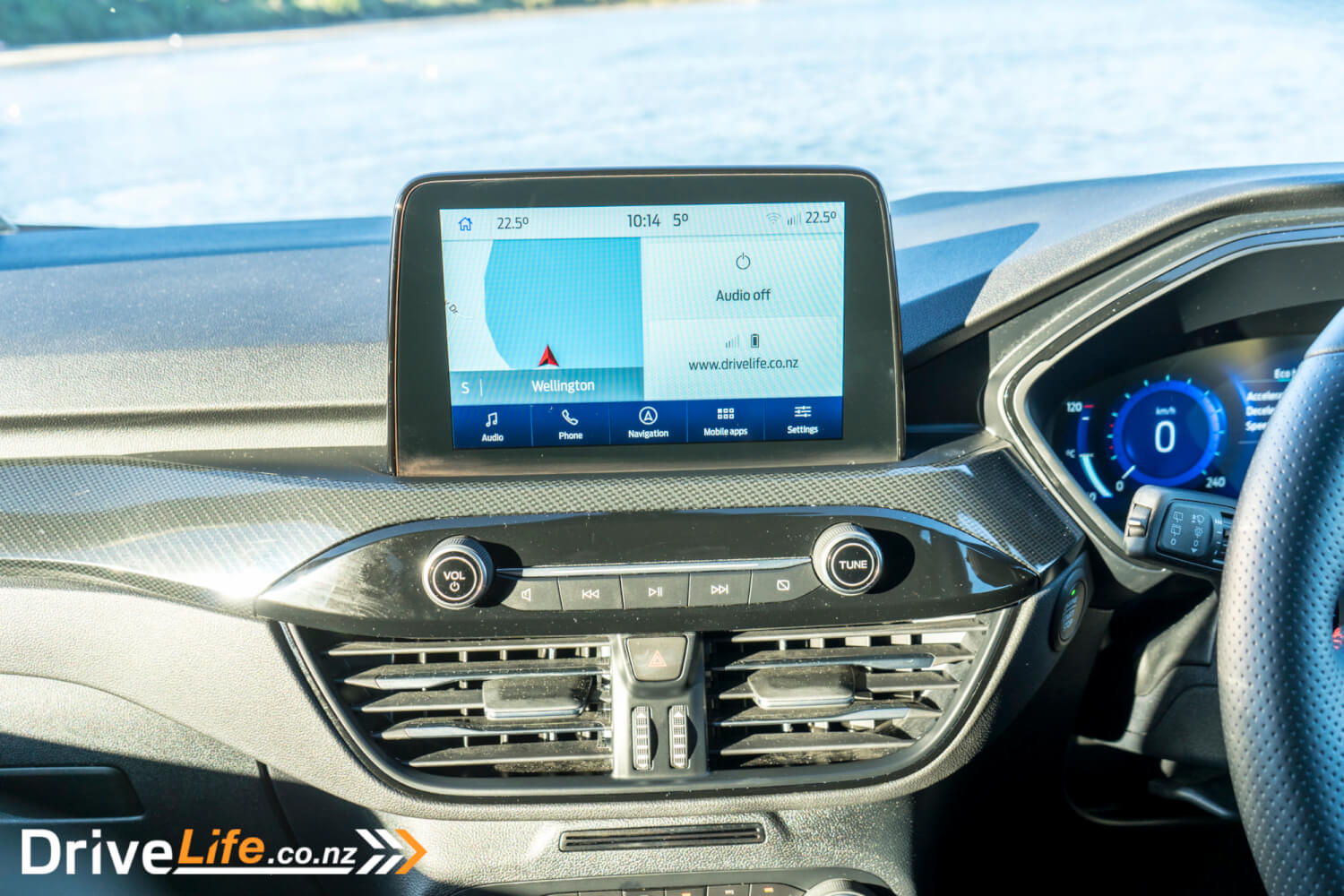
The exterior styling didn’t float my boat either. Whip off the Ford badges, and one might be pressed to identify it from other crossovers, despite all the ST-line trims to spruce it up a bit. Perhaps the grey doesn’t do it any favours.
As crossovers go, the Escape is incredibly easy to live with and is a good all-rounder. If Ford can tweak this chassis a bit, there’s not a lot that would deter one from buying an Escape. This is definitely one for the shortlist.
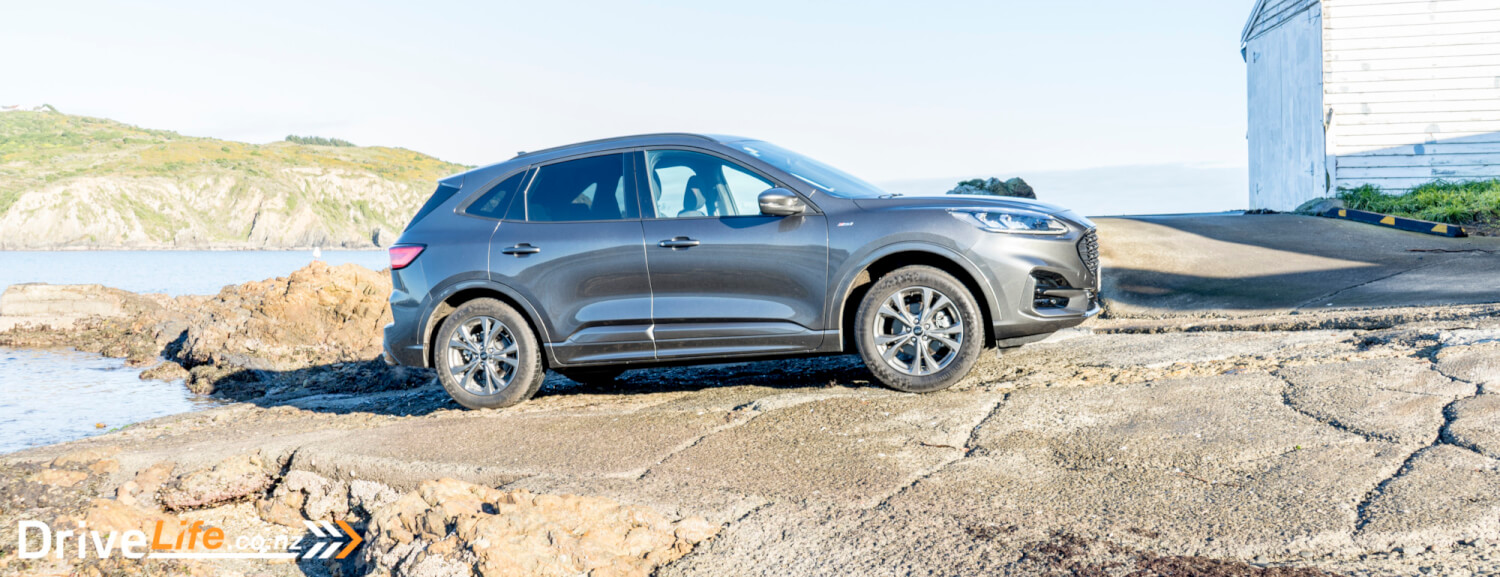
What’s The Competition For The 2021 Ford Escape ST-Line?
| Brand/Model | Engine | Power/Torque kW/Nm | Cargo capacity, litres | Fuel L/100km | Price |
| Skoda Karoq Sportline TSi AWD | 2.0-litre, 4-cylinder turbo-petrol | 140/320 | 521 | 7.6 | $55,590 |
| Volkswagen Tiguan TSi Style AWD | 2.0-litre, 4-cylinder turbo-petrol | 132/320 | 615 | 8.6 | $59,990 |
| Renault Koleos Intens AWD | 2.5-litre, 4-cylinder | 126/226 | 458 | 8.3 | $52,990 |
| Ford Escape ST Line AWD | 2.0-litre, 4-cylinder turbo-petrol | 183/387 | 556 | 8.6 | $50,990 |
| Subaru Forester Preimium AWD | 2.5-litre, 4-cylinder petrol | 136/239 | 498 | 7.4 | $49,990 |
| Peugeot 3008 Allure FWD | 1.6-litre, 3-cylinder petrol turbo | 121/240 | 520 | 7.0 | $49,990 |
| Mazda CX-5 GSX AWD | 2.5-litre, 4-cylinder petrol | 140/252 | 455 | 7.4 | $46,895 |
| Mitsubishi Eclipse VRX AWD | 1.5-litre, 4-cylinder turbo petrol | 112/254 | 405 | 7.7 | $43,990 |
| Toyota RAV4 GXL AWD | 2.5-litre, 4-cylinder petrol | 152/243 | 542 | 7.7 | $43,990 |
| Nissan Qashqai Ti FWD | 2.0-litre, 4-cylinder petrol | 106/200 | 430 | 6.9 | $42,990 |
| Hyundai Tucson 1.6 Active AWD | 1.6-litre, 4-cylinder petrol | 132/265 | 620 | 6.9 | $57,990 |
| MG HS Essence AWD | 2.0-litre 4-cylinder turbo-petrol | 168/360 | 463 | 9.5 | $45,990 |
| Honda CR-V Sport Premium AWD | 1.5-litre, 4-cylinder turbo-petrol | 140/240 | 522 | 7.4 | $43,990 |
| Haval Jolion Lux FWD | 1.5-litre, 4-cylinder turbo-petrol | 110/220 | NA | 8.1 | $33,990 |
Competition, much? One thing is for certain, nothing has the power or torque of the Escape, although the MG HS comes very close.
What’s The Pros and Cons Of The 2021 Ford Escape ST-Line?
| Pros Smooth, powerful, torquey engine Transmission Spacious interior Acceleration Ease of driving Fuel economy | Cons Price Transmission can be a little jerky Traffic Sign recognition is unreliable |
2021 Ford Escape ST-Line – Specfications
| Vehicle Type | 5-door, AWD medium SUV |
| Starting Price | $50,990 |
| Price as Tested | $50,990 |
| Engine | 2.0L GTDI EcoBoost |
| Power, Torque kW/Nm | 183@5,700rpm 387@3,100rpm |
| Transmission | 8-speed automatic with paddle shifters |
| Spare Wheel | Space saver |
| Kerb Weight, Kg | 1,611 |
| Length x Width x Height, mm | 4614x1883x1670 |
| Cargo Capacity, litres Seats up/seats down | 556/1,478 |
| Fuel capacity, litres | 57 |
| Fuel Efficiency, L/100Km | Advertised Spec – combined – 8.6 Real World Test – combined – 8.4 Low Usage: 0-6 / Medium Usage 6-12 / High Usage 12+ |
| Towing Capacity Kg, unbraked/braked | NA/1,800 |
| Turning circle, metres | 11.4 Small: 6-10m / Medium 10-12m / Large 12m+ |
| Warranty | 5 Years, Unlimited Km 3 Years Roadside Assistance |
| ANCAP Safety Ratings | 5 Star |


